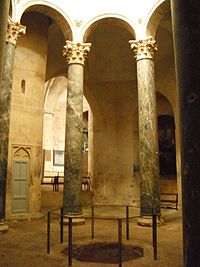Merovingian art and architecture




Merovingian artis the art of theMerovingian dynastyof theFranks,which lasted from the 5th century to the 8th century in present-dayFrance,Beneluxand a part ofGermany. The advent of the Merovingian dynasty inGaulin the 5th century led to important changes in the field of arts. Sculptural arts consisted of the ornamentation ofsarcophagi,altarsand ecclesiastical furniture.Gold workand the new medium ofmanuscript illuminationintegrated "barbarian"animal-styledecoration, withLate Antiquemotifs, and other contributions from as far as Syria or Ireland to constitute Merovingian art.
Architecture
[edit]The unification of theFrankishkingdom underClovis I(465–511) and his successors, corresponded with the need for the building of churches, and especially monastery churches, as these were now the power-houses of the Merovingian church. Plans often continued theRomanbasilicatradition, but also took influences from as far away as Syria and Armenia. In the East, most structures were in timber, but stone was more common for significant buildings in the West and in the southern areas that later fell under Merovingian rule. Most major churches have been rebuilt, usually more than once, but many Merovingian plans have been reconstructed from archaeology.
The description inBishopGregory of Tours'History of the Franksof the basilica of Saint-Martin, built at Tours bySaint Perpetuus(bishop 460–490) at the beginning of the period and at the time on the edge of Frankish territory, gives cause to regret the disappearance of this building, one of the most beautiful Merovingian churches, which he says had 120 marble columns, towers at the East end, and several mosaics: "Saint-Martin displayed the vertical emphasis, and the combination of block-units forming a complex internal space and the correspondingly rich external silhouette, which were to be the hallmarks of the Romanesque".[1]A feature of the basilica of Saint-Martin that became a hallmark of Frankish church architecture was the sarcophagus or reliquary of the saint raised to be visible and sited axially behind the altar, sometimes in theapse.There are no Roman precedents for this Frankish innovation.[2]TheSaint Peter's churchinVienneis the only surviving one. A number of other buildings, now lost, including the Merovingian foundations ofSaint-Denis,St. GereoninCologne,and theAbbey of Saint-Germain-des-Présin Paris, are described as similarly ornate.
Some small buildings remain, especiallybaptisteries,which fell out of fashion and were spared rebuilding. InAix-en-Provence,RiezandFréjus,three octagonalbaptistries,each covered with a cupola on pillars, are testimony to the influence of oriental architecture (the baptistry of Riez, in theAlpes-de-Haute-Provence,recalls that of St. George, Ezra',Syria). Very different from these Provençal baptistries, except for the quatrefoil one ofVenasque,that ofSt. JeanatPoitiers(6th century) has the form of a rectangle flanked by three apses. The original building has probably undergone a number of alterations but preserves in its decoration (marble capitals) a Merovingian character.
Among the very manycrypts,numerous due to the importance of the cult of saints at the time, only those of St. Seurin, Bordeaux,St. Laurent, Grenoble,the crypt of the Abbey of Saint Médard in Soissons,and the abbey ofJouarre(7th century) survive.
Other arts
[edit]
By the 7th century, the abilities of Merovingian craftsmen must have been well regarded, as they were brought to England to re-introduce glass making skills, and Merovingian stonemasons were used to build English churches.[3]Merovingian masons also employed theopus gallicumextensively and are responsible for bringing it to England and bequeathing it to theNormans,who brought it to Italy.
Very few Merovingian illuminated manuscripts survive, of which the most richly decorated is the 8th centuryGelasian Sacramentaryin theVatican Library,which has geometric and animal decoration, less complex than that of theInsular artof the British Isles, but like it derived from metalwork motifs, with some influence from Late Antiquity and the Near-East. The principal centres were theAbbey of Luxeuil,anIrishfoundation, and later its daughter house atCorbie Abbey.
A large Merovingian art collection in Berlin was taken by Soviet troops to Russia, where it remains to this day.[4][5][6]
Gallery
[edit]-
Baptistery of Riez
-
Baptistery ofcathedral Saint-Léonce de Fréjus
-
Baptistery Saint-Jean de Venasque
-
Crypt of Notre-Dame de Jouarreand sarcophagi
-
Crypt of Notre-Dame de Jouarre
-
Capital in the crypt of Notre-Dame de Jouarre
See also
[edit]Notes
[edit]- ^V.I. Atroshenko and Judith Collins,The Origins of the Romanesque(Lund Humphries, London) 1985, p. 48.ISBN0-85331-487-X
- ^Werner Jacobsen, "Saints' Tombs in Frankish Church Architecture"Speculum72.4 (October 1997:1107–1143).
- ^Bede.The Lives of the Holy Abbots of Wearmouth and Jarrow.
- ^Effros, Bonnie (14 June 2012).Uncovering the Germanic Past: Merovingian Archaeology in France, 1830–1914.Oxford University Press. p. 298.ISBN9780199696710.
- ^(www.dw.com), Deutsche Welle (16 August 2007)."Germany Worried About Losing Out in Looted Art Row | Culture | DW.COM | 16.08.2007".DW.COM.DW.Retrieved19 August2016.
- ^Harding, Luke (13 March 2007)."Russia displays looted German treasure".The Guardian.Retrieved19 August2016.
References
[edit]- European Commission:Raphaël Programme.The Normans, a European people: The Norman heritage, 10th – 12th century.Architectural Heritage: Italy — the Molise§8 Fortifications and castles: Fortifications — The opus gallicum in the fortifications.2004.
- Gilbert, Edward."Brixworth and the English Basilica."The Art Bulletin,Vol. 47, No. 1. (Mar., 1965), pp 1–20.
- Bede.Lives of the Holy Abbots of Wearmouth and Jarrow.
External links
[edit]- Age of spirituality: late antique and early Christian art, third to seventh centuryfrom The Metropolitan Museum of Art
- A large collection of Merovingian artwas taken fromBerlinby the Soviet military forces in 1945.







